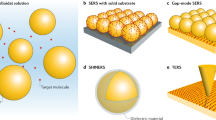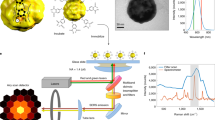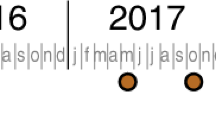Abstract
The remarkable optical properties of metal nanoparticles are governed by the excitation of localized surface plasmon resonances (LSPRs). The sensitivity of each LSPR mode, whose spatial distribution and resonant energy depend on the nanoparticle structure, composition and environment, has given rise to many potential photonic, optoelectronic, catalytic, photovoltaic, and gas- and bio-sensing applications1,2,3. However, the precise interplay between the three-dimensional (3D) nanoparticle structure and the LSPRs is not always fully understood and a spectrally sensitive 3D imaging technique is needed to visualize the excitation on the nanometre scale. Here we show that 3D images related to LSPRs of an individual silver nanocube can be reconstructed through the application of electron energy-loss spectrum imaging4, mapping the excitation across a range of orientations, with a novel combination of non-negative matrix factorization5,6, compressed sensing7,8 and electron tomography9. Our results extend the idea of substrate-mediated hybridization of dipolar and quadrupolar modes predicted by theory, simulations, and electron and optical spectroscopy10,11,12, and provide experimental evidence of higher-energy mode hybridization. This work represents an advance both in the understanding of the optical response of noble-metal nanoparticles and in the probing, analysis and visualization of LSPRs.
This is a preview of subscription content, access via your institution
Access options
Subscribe to this journal
Receive 51 print issues and online access
$199.00 per year
only $3.90 per issue
Buy this article
- Purchase on Springer Link
- Instant access to full article PDF
Prices may be subject to local taxes which are calculated during checkout




Similar content being viewed by others
References
Maier, S. A. & Atwater, H. A. Plasmonics: localization and guiding of electromagnetic energy in metal/dielectric structures. J. Appl. Phys. 98, 011101 (2005)
Schuller, J. A. et al. Plasmonics for extreme light concentration and manipulation. Nature Mater. 9, 193–204 (2010)
Anker, J. N. et al. Biosensing with plasmonic nanosensors. Nature Mater. 7, 442–453 (2008)
Jeanguillaume, C. & Colliex, C. Spectrum-image: the next step in EELS digital acquisition and processing. Ultramicroscopy 28, 252–257 (1989)
Paatero, P. & Tapper, U. Positive matrix factorization: a non-negative factor model with optimal utilization of error estimates of data values. Environmetrics 5, 111–126 (1994)
Lee, D. D. & Seung, H. S. Learning the parts of objects by non-negative matrix factorization. Nature 401, 788–791 (1999)
Donoho, D. L. Compressed sensing. IEEE Trans. Inf. Theory 52, 1289–1306 (2006)
Candes, E. J., Romberg, J. & Tao, T. Robust uncertainty principles: exact signal reconstruction from highly incomplete frequency information. IEEE Trans. Inf. Theory 52, 489–509 (2006)
Leary, R., Saghi, Z., Midgley, P. A. & Holland, D. J. Compressed sensing electron tomography. Ultramicroscopy 131, 70–91 (2013)
Ringe, E. et al. Unraveling the effects of size, composition, and substrate on the localized surface plasmon resonance frequencies of gold and silver nanocubes: a systematic single-particle approach. J. Phys. Chem. C 114, 12511–12516 (2010)
Zhang, S., Bao, K., Halas, N. J., Xu, H. & Nordlander, P. Substrate-induced Fano resonances of a plasmonic nanocube: a route to increased-sensitivity localized surface plasmon resonance sensors revealed. Nano Lett. 11, 1657–1663 (2011)
Mazzucco, S. et al. Ultralocal modification of surface plasmons properties in silver nanocubes. Nano Lett. 12, 1288–1294 (2012)
Kneipp, K., Kneipp, H., Itzkan, I., Dasari, R. R. & Feld, M. S. Surface-enhanced Raman scattering and biophysics. J. Phys. Condens. Matter 14, R597 (2002)
Nelayah, J. et al. Mapping surface plasmons on a single metallic nanoparticle. Nature Phys. 3, 348–353 (2007)
Yurtsever, A., van der Veen, R. M. & Zewail, A. H. Subparticle ultrafast spectrum imaging in 4D electron microscopy. Science 335, 59–64 (2012)
Sherry, L. J. et al. Localized surface plasmon resonance spectroscopy of single silver nanocubes. Nano Lett. 5, 2034–2038 (2005)
Korte, K. E., Skrabalak, S. E. & Xia, Y. Rapid synthesis of silver nanowires through a CuCl-or CuCl2-mediated polyol process. J. Mater. Chem. 18, 437–441 (2008)
Nelayah, J. et al. Direct imaging of surface plasmon resonances on single triangular silver nanoprisms at optical wavelength using low-loss EFTEM imaging. Opt. Lett. 34, 1003–1005 (2009)
Nicoletti, O. et al. Surface plasmon modes of a single silver nanorod: an electron energy loss study. Opt. Express 19, 15371–15379 (2011)
García de Abajo, F. J. Optical excitations in electron microscopy. Rev. Mod. Phys. 82, 209–275 (2010)
Comon, P. Handbook of Blind Source Separation: Independent Component Analysis and Applications (Academic, 2010)
de la Peña, F. et al. Mapping titanium and tin oxide phases using EELS: an application of independent component analysis. Ultramicroscopy 111, 169–176 (2011)
Langbein, D. Normal modes at small cubes and rectangular particles. J. Phys. Math. Gen. 9, 627–644 (1976)
Fuchs, R. Theory of the optical properties of ionic crystal cubes. Phys. Rev. B 11, 1732–1740 (1975)
Lade, S. J., Paganin, D. & Morgan, M. J. Electron tomography of electromagnetic fields, potentials and sources. Opt. Commun. 253, 392–400 (2005)
Hohenester, U., Ditlbacher, H. & Krenn, J. R. Electron-energy-loss spectra of plasmonic nanoparticles. Phys. Rev. Lett. 103, 106801 (2009)
Boudarham, G. & Kociak, M. Modal decompositions of the local electromagnetic density of states and spatially resolved electron energy loss probability in terms of geometric modes. Phys. Rev. B 85, 245447 (2012)
García de Abajo, F. J. Relativistic energy loss and induced photon emission in the interaction of a dielectric sphere with an external electron beam. Phys. Rev. B 59, 3095–3107 (1999)
Geuquet, N. & Henrard, L. EELS and optical response of a noble metal nanoparticle in the frame of a discrete dipole approximation. Ultramicroscopy 110, 1075–1080 (2010)
Keenan, M. R. & Kotula, P. G. Accounting for Poisson noise in the multivariate analysis of ToF-SIMS spectrum images. Surf. Interface Anal. 36, 203–212 (2004)
Lin, C.-J. Projected gradient methods for nonnegative matrix factorization. Neural Comput. 19, 2756–2779 (2007)
Lustig, M., Donoho, D. & Pauly, J. M. Sparse MRI: the application of compressed sensing for rapid MR imaging. Magn. Reson. Med. 58, 1182–1195 (2007)
Johnson, P. B. & Christy, R. W. Optical constants of the noble metals. Phys. Rev. B 6, 4370–4379 (1972)
Johnson, W. L., Kim, S. A., Utegulov, Z. N., Shaw, J. M. & Draine, B. T. Optimization of arrays of gold nanodisks for plasmon-mediated Brillouin light scattering. J. Phys. Chem. C 113, 14651–14657 (2009)
Taubman, D. S. & Marcellin, M. W. JPEG2000: standard for interactive imaging. Proc. IEEE 90, 1336–1357 (2002)
Fessler, J. A. & Sutton, B. P. Nonuniform fast Fourier transforms using min-max interpolation. IEEE Trans. Signal Process. 51, 560–574 (2003)
Buckheit, J. B. & Donoho, D. L. Wavelab and reproducible research. Lect. Notes Stat. 103, 55–81 (1995)
Arslan, I., Tong, J. R. & Midgley, P. A. Reducing the missing wedge: high-resolution dual axis tomography of inorganic materials. Ultramicroscopy 106, 994–1000 (2006)
Tong, J., Arslan, I. & Midgley, P. A novel dual-axis iterative algorithm for electron tomography. J. Struct. Biol. 153, 55–63 (2006)
Laurberg, H., Christensen, M. G., Plumbley, M. D., Hansen, L. K. & Jensen, S. H. Theorems on positive data: on the uniqueness of NMF. Comput. Intell. Neurosci. 2008, 764206 (2008)
Gilbert, P. Iterative methods for the three-dimensional reconstruction of an object from projections. J. Theor. Biol. 36, 105–117 (1972)
Palik, E. D. Handbook of Optical Constants of Solids Vol. 1, 350–357 (Academic, 1998)
Agulleiro, J. I. & Fernandez, J. J. Fast tomographic reconstruction on multicore computers. Bioinformatics 27, 582–583 (2011)
Acknowledgements
We acknowledge the Nano Research Facility (NRF), School of Engineering and Applied Science, Washington University, St Louis, USA for the nanoparticle synthesis. The NRF is a member of the US National Nanotechnology Infrastructure Network, supported by the US National Science Foundation under NSF award no. ECS-0335765. F.d.l.P. and C.D. acknowledge funding from the ERC under grant no. 259619 PHOTO EM. C.D. acknowledges the Royal Society for funding. P.A.M. and O.N. acknowledge financial support from the European Union’s Seventh Framework Programme (FP/2007-2013) under the European Research Council ERC Grant Agreement 291522-3DIMAGE and under Grant Agreement 312483-ESTEEM2 (Integrated Infrastructure Initiative – I3). D.J.H. acknowledges Microsoft Research Connections and the EPSRC (grants nos EP/K008218/1 and EP/K039318/1) for financial support. We thank A. Howie, M. Kociak, E. Ringe and S. M. Collins for discussions and FEI (in particular E. Yucelen and S. Lazar) for access to an FEI Titan Microscope at the FEI Nanoport in Eindhoven.
Author information
Authors and Affiliations
Contributions
P.A.M. and O.N. designed the experiment. O.N. performed the electron microscopy. F.d.l.P. performed simulations and data analysis. R.K.L. and D.J.H. performed compressed sensing electron tomography. All authors interpreted and discussed the experimental results and wrote and edited the manuscript.
Corresponding author
Ethics declarations
Competing interests
The authors declare no competing financial interests.
Extended data figures and tables
Extended Data Figure 1 Re-projections of the LSPR components.
Re-projections of the reconstructed 3D volumes of the five LSPR components, at the same tilt angles as the experimental data acquisition. Letters α–ε correspond to those of Figs 1–3. The orientation is as in Fig. 1, with the substrate–cube interface towards the top of the image at negative tilts. To exclude false regions of localized intensity that arose at the periphery of some of the reconstruction volumes (owing to the imperfections involved in seeking a tomographic reconstruction from so few tilt-series images), the re-projected volume was restricted to that immediately surrounding the nanocube and LSPRs.
Extended Data Figure 2 Energy-filtered series of the STEM EELS spectrum images.
Energy filtered series for the 0° tilt (a) and the −60° (b) STEM EELS spectrum images. The images are limited to the range of interest between 1 and 4 eV for LSPRs of the silver nanocube. The EELS signal in the images is integrated over an energy window 0.2 eV wide.
Extended Data Figure 3 DDA EELS simulations of a silver nanocube.
a, b, DDA EELS simulated as functions of position (as shown by the blue dotted line) for a 100-nm silver cube with rounded corners in vacuum with dielectric function tabulated in ref. 33 (a), and for a 100-nm silver cube with rounded corners in vacuum with dielectric function tabulated in ref. 42 (b). c, 2D tomographic reconstructions of the five spectral features identified in a and b (C1, C2, C3, E and F), made from a tilt series of simulated spectra in which the cube is rotated about a cube axis perpendicular to the beam. The five spectral features correspond to lowest-energy (dipole) corner (C1), higher-energy corner (C2 and C3), edge (E) and face (F) components. We note that the individual components C2 and C3 are not separated if the dielectric tabulation in ref. 42 is used, as in b. Each reconstruction is scaled independently. There are significant negative values only in the reconstruction of the C3 component, which corresponds to a singly degenerate octupole mode. Tomographic reconstructions made from this tilt series were obtained using SIRT41, implemented using the TOMO3D software package43.
Supplementary information
3D rendering of the LSPR components.
This video shows a combined 3D rendering of the LSPR components, as displayed in Fig. 3 of the manuscript. (MPG 16698 kb)
3D perspective view of each LSPR component.
This video shows a 3D perspective view of each LSPR component, in respective energy order, leading to a combined 3D rendering, as displayed in Fig. 3 of the manuscript. (MPG 28893 kb)
Rights and permissions
About this article
Cite this article
Nicoletti, O., de la Peña, F., Leary, R. et al. Three-dimensional imaging of localized surface plasmon resonances of metal nanoparticles. Nature 502, 80–84 (2013). https://doi.org/10.1038/nature12469
Received:
Accepted:
Published:
Issue Date:
DOI: https://doi.org/10.1038/nature12469
This article is cited by
-
Influence of sintering temperature on structural and optical properties of Cd0.5Cu0.5CrxFe2−xO4 ferrites
Scientific Reports (2023)
-
Machine learning for nanoplasmonics
Nature Nanotechnology (2023)
-
A Review of Alkali Tungsten Bronze Nanoparticles for Applications in Plasmonics
Plasmonics (2023)
-
Large-Area, Ultrahigh-Enhancement, and Array-Type Hot Spots in Plasmonic Nanocube Dimer-on-Film Nanocavity
Plasmonics (2023)
-
Machine learning in scanning transmission electron microscopy
Nature Reviews Methods Primers (2022)
Comments
By submitting a comment you agree to abide by our Terms and Community Guidelines. If you find something abusive or that does not comply with our terms or guidelines please flag it as inappropriate.



